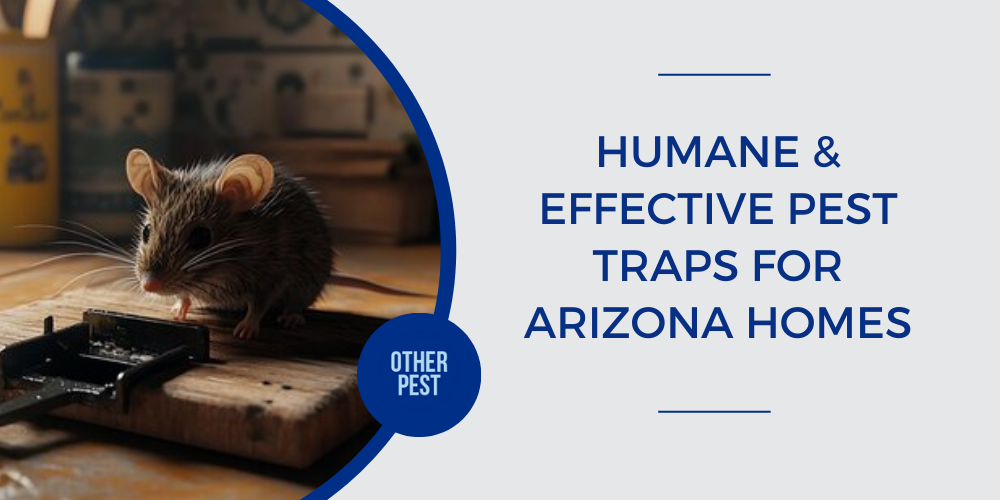Whether you're dealing with a hungry javelina munching on your garden or a sneaky rodent trying to make itself at home, understanding which traps work best can save you time, frustration, and a whole lot of headache. In this blog, we’ll explore the different types of traps, when to use them, and a few tips on keeping your home critter-free in the beautiful but wild Arizona landscape.
The Classic: Snap Traps
Most people faced with the need to catch or trap a pesky rodent think of the classic snap trap. The classic snap trap is great for catching rats, mice, and other small rodents that may be found scurrying around a garage or attic. A snap trap has a spring-loaded bar that slams shut when triggered. To lure and trap a rat or mouse, it all begins with the bait (think peanut butter, cheese, or even a little leftover pizza). Just be sure to check traps daily—there’s nothing worse than a forgotten catch.
How to Use It:
Place the trap along walls where rodents tend to run, as they don’t usually venture out into the middle of the room.
Be sure to use enough bait to entice the little critter, but not so much that it causes the trap to misfire.
Be mindful of where you place them. You don’t want to be accidentally snapping your finger (or worse, your toe) on one!
Where to Use It:
Place traps along walls, behind appliances, or in dark corners—wherever you notice mouse droppings or signs of chewing.
If you’re using a snap trap for rats, place it near pathways where you've seen signs of activity.
Pro Tip: If you're dealing with a more frequent pest problem, like an invasion of mice, set out multiple traps at once. Think of it as an all-you-can-eat buffet for the little critters.
The Sticky Solution: Glue Traps
Glue traps might sound simple: place, stick, done, but they come with a warning. These traps are incredibly effective for small pests like cockroaches, crickets, bed bugs and scorpions, which are abundant in the Valley. Place glue traps under furniture, along baseboards, or near water sources (kitchens and bathrooms are prime locations).
How to Use It:
For best results, place glue traps in areas where pests are most likely to travel, such as along walls, behind appliances, or near food and water sources.
Be sure to position them in quiet, less disturbed places where pests feel comfortable.
Use just enough bait to draw them in without overwhelming the adhesive surface.
Where to Use It:
Glue traps are most effective in areas where you’ve noticed ongoing activity.
Make sure to inspect the traps often to ensure the critters don’t stay stuck too long.
Pro Tip: Glue traps can catch more than you bargained for, including lizards and other harmless critters. If you’re using them, be strategic and mindful of unintended victims. If you do catch a non-pest, a bit of vegetable oil can help release them safely.
The Humane Option: Live Traps
For those who prefer the "catch and release" method, live traps are your go-to solution. These traps capture animals without harming them, allowing you to relocate them far from your property. Live traps are an ideal option for catching raccoons, opossums, and squirrels. It can also work well for the occasional challenge from visiting javelina interested in your compost bin.
How to Use It:
Set up the live trap in areas where you’ve noticed animal activity (like under your porch, near a shed, or in the garden).
Use bait that will attract the specific animal. For example, peanut butter works wonders for raccoons, while fruits are the opossum’s snack of choice.
Once the trap is triggered, your new furry friend will be safely contained, and all you have to do is take them for a “field trip” far away from your property. Just be sure to check local regulations to ensure you’re relocating animals in a safe, legal manner.
When to Use It:
Perfect for animals you don’t want to hurt or harm—this is the trap for situations like squirrels or raccoons.
Ideal for animals causing damage or a nuisance but not a direct threat.
Set up traps when you notice signs like gnaw marks, scavenged food, or animals in your yard.
Check traps regularly to avoid keeping animals inside too long.
Pro Tip: Always wear gloves when handling live traps to avoid leaving behind human scent, which might deter animals from entering. Gloves also protect you from potential scratches or bites during release. Additionally, clean the trap thoroughly after each use to maintain its effectiveness.
Bugging Out: Insect Traps
Whether it’s flies buzzing at your barbecue, mosquitoes crashing your patio party, or the occasional scorpion hiding in your shoe, having the right trap can be a game-changer.
For flies, a classic flypaper or fly bait station does the trick. Hang these near trash bins or in areas where flies seem to congregate. These sticky traps will capture flies as they land, preventing them from buzzing around your food or drinks. For more intense fly problems, a bait station will attract and trap even the most persistent pests.
Mosquitoes are another challenge in Arizona. To tackle these winged annoyances, UV light traps are a great option—they lure mosquitoes in with light and trap them inside a container. If you're feeling adventurous, you can create a DIY mosquito trap using a plastic bottle and a sweet sugary mixture ( sugar and yeast). Mosquitoes can't resist the sweet scent, and they’ll end up trapped inside the bottle before they have a chance to bite.
Pro Tip: To increase the effectiveness of your insect traps, place them in areas that are darker and more hidden. Flies, mosquitoes, and scorpions all prefer areas of shelter where they can avoid predators and thrive in peace. And remember—regular maintenance is key! Empty or replace traps as needed to keep your space pest-free.
How to Keep the Critters Out in the First Place
The best trap is the one that never needs to be used. So, let’s talk about how to make sure you don’t have to deal with trapping pests in the first place.
Seal Up the Cracks: Sealing up gaps around doors, windows, and pipes can prevent critters from sneaking inside.
Clear the Yard: Keep your lawn, bushes, and trees well-trimmed, as these are prime hiding spots for rodents and other animals.
Keep Food Indoors: If you have outdoor pets or a garden, make sure all food is sealed tightly. Animals are sneaky—if they smell food, they’ll find a way in.
Use Natural Repellents: Plants like lavender, mint, and eucalyptus can keep rodents and insects at bay. A little garden makeover might be all you need!
Whether you're trapping a pesky rat or relocating a curious raccoon, there is no one-size-fits-all solution. Arizona’s wildlife is as diverse as its landscape, but with the right tools and a little know-how, you can keep your home and lawn critter-free. Just remember, when it comes to trapping unwanted animals and insects, it is nice to take a humane approach when possible.
For questions, concerns and solutions, visit any of our Bug & Weed Mart stores in the Valley and talk to our experts on affordable, DIY pest solutions.

